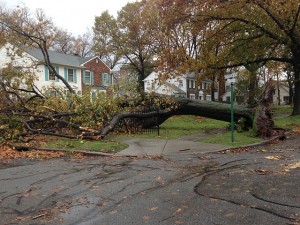By Isabelle Aubrun, CCCL Intern (Brown University)
On June 2, Secretary of the US Department of Housing and Development (HUD) Shaun Donovan announced the Rebuild by Design Competition’s six winners. Created by President Obama’s Hurricane Sandy Rebuilding Task Force in 2013, ‘Rebuild by Design’ awards HUD funding to infrastructure projects in locations hardest hit by Superstorm Sandy in 2012. Rebuild by Design drew engineers, designers, urban planners, local government officials and community members together to collaboratively identify regional vulnerabilities and devise creative, implementable solutions.
 All six winning projects are committed to building a more ecologically, economically, and environmentally resilient coast. The competition sought “fundable and implementable” solutions specifically to rebuild in Sandy’s wake, as well as models that could protect New York and New Jersey from increasingly severe weather in coming years. Many hope that these design proposals will also serve as a model for coastal cities nationwide.[1]
All six winning projects are committed to building a more ecologically, economically, and environmentally resilient coast. The competition sought “fundable and implementable” solutions specifically to rebuild in Sandy’s wake, as well as models that could protect New York and New Jersey from increasingly severe weather in coming years. Many hope that these design proposals will also serve as a model for coastal cities nationwide.[1]
HUD will distribute approximately $920 million – from HUD Community Development Block Grants for Disaster Recovery, the Rockefeller Foundation, and affiliated foundations – across the six winning projects. Over the next four to five years, the projects will be implemented. While many have harshly criticized the region’s lethargic efforts to fund and execute rebuilding efforts,[2] Rebuild by Design offers a forward-looking vision to hopefully prevent future devastation.
Rebuild by Design “has made resilience a national priority,” drawing support from government officials across the region and the nation.[3] The six winning teams cleverly identified ways to integrate the coastal and built environments in order to optimize waterfront accessibility during stable conditions and maximize safety during severe weather. Secretary Donovan praised the competitors’ ingenuity: “It is my hope that Rebuild by Design will inspire other public-private partnerships to spur innovation and resilience in other parts of the country… investing in these proposals, we are going to ensure that when the next storm comes, the region will be safer and better prepared.”[4] In fact, on June 14, United States Department of the Interior’s Hurricane Sandy Coastal Resilience Grant Program announced plans to allocate $102.7 million in federal grant money to 11 states in the Northeast most in need of protection against future storms. According to Interior Secretary Sally Jewell, these projects will focus on expanding natural protective infrastructure such as wetlands, dunes, streams and tidal buffers.[5]
“There is no doubt that climate change is real and that it is here,” U.S. Senator Kirsten Gillibrand reminded attendees at the Rebuild by Design awards ceremony. [6] Creative and well-funded initiatives such as the abovementioned competitions are long-awaited proof that our government, following a destructive storm like Sandy, might finally be ready to prioritize environmentally resilient development when it threatens their backyard.
See below for the Rebuild by Design winning projects:
(1) MIT CAU + ZUS + URBANISTEN: “The New Meadowlands,” New Jersey Meadowlands[7]
New Jersey’s Meadowlands were flooded by a massive storm surge during Hurricane Sandy and, based on research in the storm’s aftermath, it is clear the wetlands were insufficiently safeguarded from deluge. The NJ towns of Little Ferry and Moonachie, in the Meadowlands, were almost completely flooded, and residents were displaced for at least two months.[8] As such, “The New Meadowlands” intends to “protect, connect, and grow” New Jersey’s rich wetlands by simultaneously fortifying them against future storms and making them an accessible resource for surrounding communities. The new “Meadowpark,” building upon work already done by the New Jersey Meadowlands Commission, will build berms and marshes to protect against ocean surges and collect rainfall. The “Meadowband” will encircle the reimagined Meadowlands and provide additional protection to preserve the wetlands. It will provide pedestrian access to the wetlands, serve as the road for a Rapid Transit bus line and offer recreational spaces for surrounding residents.
(2) OMA: “Resist, Delay, Store, Discharge: A Comprehensive Strategy for Hoboken,” New Jersey (Hoboken, Weehawken and Jersey City)[9]
OMA’s project will protect the waterfronts of Hoboken, Weehawken and Jersey City through their project “Resist, Delay, Store, Discharge,” which is expected to do exactly that with the waters from heavy rainfall, flash flooding and storm surge. Hoboken, Weehawken and Jersey City were hit hard by during Sandy, but were plagued by frequent flooding long before the Superstorm exposed their vulnerabilities on a national scale. OMA’s project used extreme, worst-case scenario water level projections to devise its protective measures. These strategies include coastal parks and wetlands to act as a protective wall to resist storm surge. Civic infrastructure adjustments such as permeable pavement will delay the impact of heavy rainfall. A green drainage system of water pumps and rain gardens will discharge excess rainwater. Finally, additional water pumps and drainage infrastructure will discharge the water that has overwhelmed the cities’ drainage capacity.
(3) The Interboro Team: “Living With the Bay,” South Shore Long Island, New York[10]
“Living with the Bay” addresses Long Island’s multiple water-based threats with an assortment of adaptive techniques for living with the Bay, rather than retreating from its shores. The proposal calls for the construction of marshes and dikes along the urbanized coast to lessen damage from storm surge and projected sea level rise. These marshes will reduce extreme wave activity, contribute to the Bay’s rich ecology, and provide new recreational water access. Additionally, The Interboro Team proposes expanding housing options on elevated land, and near public transportation. These multiple strategies will create what the Interboro Team calls a “buffered bay.”
(4) SCAPE/Landscape Architecture: “Living Breakwaters,” Staten Island, New York[11]
Staten Island’s extensive coastline makes it especially susceptible to erosion and extreme wave action, as demonstrated by Sandy’s devastation in many coastal neighborhoods. Instead of creating a wall between residential communities and the waterfront, “Living Breakwaters” will create safeguards within the New York Bight – the part of the Atlantic Ocean that borders Staten Island. This project will create a ring of breakwaters – structures parallel to the shore that reduce the intensity of a wave once it hits land – along the Staten Island coast. Along with these defenses, “Living Breakwaters” will intersperse reefs in nearby waters to host finfish, shellfish and lobsters, creating an ecologically rich waterfront for easy recreation, education and study. In so doing, SCAPE/Landscape Architecture aims to empower a “new generation of harbor stewards” who benefit from their community’s safety and develop a relationship with the coasts natural offerings.
(5) The BIG Team: “The Big U,” Manhattan, New York City[12]
Storm surge from Hurricane Sandy infiltrated lower Manhattan, rising to a record 13.88 feet in Battery Park and shutting off most of the island’s power below 39th street.[13] The “Big U” will wind around 10 continuous miles of the Lower Manhattan shoreline, some of the City’s most vulnerable coast. A mixed-use proposal, the three-part Big U will at once protect the low-lying Manhattan coast and provide a recreational outdoor space along the waterfront. A “Bridging Berm” will protect the East River Park from storm surge and rising sea level while providing recreational space full of saltwater-tolerant vegetation. Releasable walls will be attached to the Manhattan Bridge, ready to be lowered in the event of a flood and offering decorative paneling when not in use. The Battery Berm will snake through lower Manhattan’s Battery Park, fortifying inlets that allowed significant flooding during Hurricane Sandy in 2012. Finally, The Big Team proposes to replace the existing Coast Guard building with a maritime museum and environmental education establishment that simultaneously creates a flood barrier and whose water-facing ground floor offers a “Reverse Aquarium” for visitors to observe tidal variation.
(6) PennDesign/OLIN: “Hunts Point Lifelines,” Hunts Point, South Bronx New York City[14]
The South Bronx’s Hunts Point peninsula contains one of the United States’ largest food distribution centers; Over 200 vendors operate on the 329 acres of Bronx land, serving approximately 22 million people and generating $5 billion in annual revenue.[15] While the peninsula emerged relatively unscathed from Hurricane Sandy, many emphasize that even the little damage it suffered during the storm indicates a need for heightened protection. Because New York City only has a two-and-a-half day food supply at any time, the City can hardly afford to have the Hunts Point market compromised.[16] The “Flood Protection Levee Lab” will create a waterfront greenway that enhances access to the shore and protects the neighborhood from flooding. “Cleanways” will be a micro-grid energy generation plant to preserve the area’s food supply should the main electrical service be compromised, as happened in other parts of the East Coast during Hurricane Sandy. Team leaders have included the possibility for Hunts Point residents to participate in the construction of their community’s flood protection infrastructure. They hope to elicit a community buy-in to climate change adaptation and strengthen the region with new jobs, economic assets and waterfront appreciation.
[1] Patrick Rodenbush, “HUD Announces Winning Proposals From the ‘Rebuild by Design’ Competition.’ US Department of Housing and Urban Development. [Press Release]. June 2, 2014.
https://portal.hud.gov/hudportal/HUD?src=/press/press_releases_media_advisories/2014/HUDNo_14-063
[2] Amy Lieberman, “Doubt Lingers for New Yorkers Devastated by Hurricane Sandy.” Huffington Post, The Blog. May 5, 2014.
https://www.huffingtonpost.com/amy-lieberman/hurricane-sandy-recovery_b_5372475.html
[3] Justin Davidson, “10 Design Ideas to Prepare Us for the Next Sandy.” New York Magazine. April 3, 2014. https://nymag.com/daily/intelligencer/2014/04/rebuild-by-design-competition-sandy.html
[4] Rodenbush, supra note 1.
[5] Wayne Parry, “Feds Give $102M in Storm Prevention to 11 States.” ABC. June 16, 2014.
https://www.abc-7.com/story/25787359/feds-give-102m-in-storm-prevention-to-11-states
[6] Rodenbush, supra note 1.
[7]MIT CAU + ZUS + URBANISTEN, “New Meadowlands: Productive City + Regional Park.” Rebuild by Design.
https://www.rebuildbydesign.org/project/mit-cau-zus-urbanisten-final-proposal/
[8]S.P. Sullivan, “What Caused the Meadowlands Deluge? No Single Berm is a Smoking Gun in Sandy’s Wake.” New Jersey Online. January 12, 2013.
[9] OMA, “Resist, Delay, Store, Discharge: A Comprehensive Strategy for Hoboken.” Rebuild by Design. https://www.rebuildbydesign.org/project/oma-final-proposal/
[10] Interboro Team, “Living With the Bay: A Comprehensive Regional Resiliency Plan for Nassau County’s South Shore.” Rebuild by Design. https://www.rebuildbydesign.org/project/interboro-team-final-proposal/
[11] SCAPE/Landscape Architecture, “Living Breakwaters.” Rebuild by Design.
https://www.rebuildbydesign.org/project/scape-landscape-architecture-final-proposal/
[12] BIG TEAM “Big U.” Rebuild by Design. https://www.rebuildbydesign.org/project/big-team-final-proposal/
[13] Isolde Raftery, “Water Surges Into Lower Manhattan As Superstorm Sandy Blasts Through.” MSNBC. October 29, 2012. https://usnews.nbcnews.com/_news/2012/10/29/14789362-water-surges-into-lower-manhattan-as-superstorm-sandy-blasts-through?lite
[14] PennDesign/OLIN, “Hunts Point Lifelines.” Rebuild by Design. https://www.rebuildbydesign.org/project/penndesignolin-final-proposal/
[15] Thomas P. DiNapoli, “An Economic Snapshot of the Hunts Point Food Distribution Center.” Office of the State Comptroller, New York City Public Information Office. https://www.osc.state.ny.us/reports/economic/huntspoint08.pdf
[16] Joe Hirsch, “Designing to Survive a Super Storm.” The Hunts Point Express. January 30, 2014. https://brie.hunter.cuny.edu/hpe/2014/01/30/designing-to-survive-a-super-storm/
image from: https://bit.ly/1lQEox2



